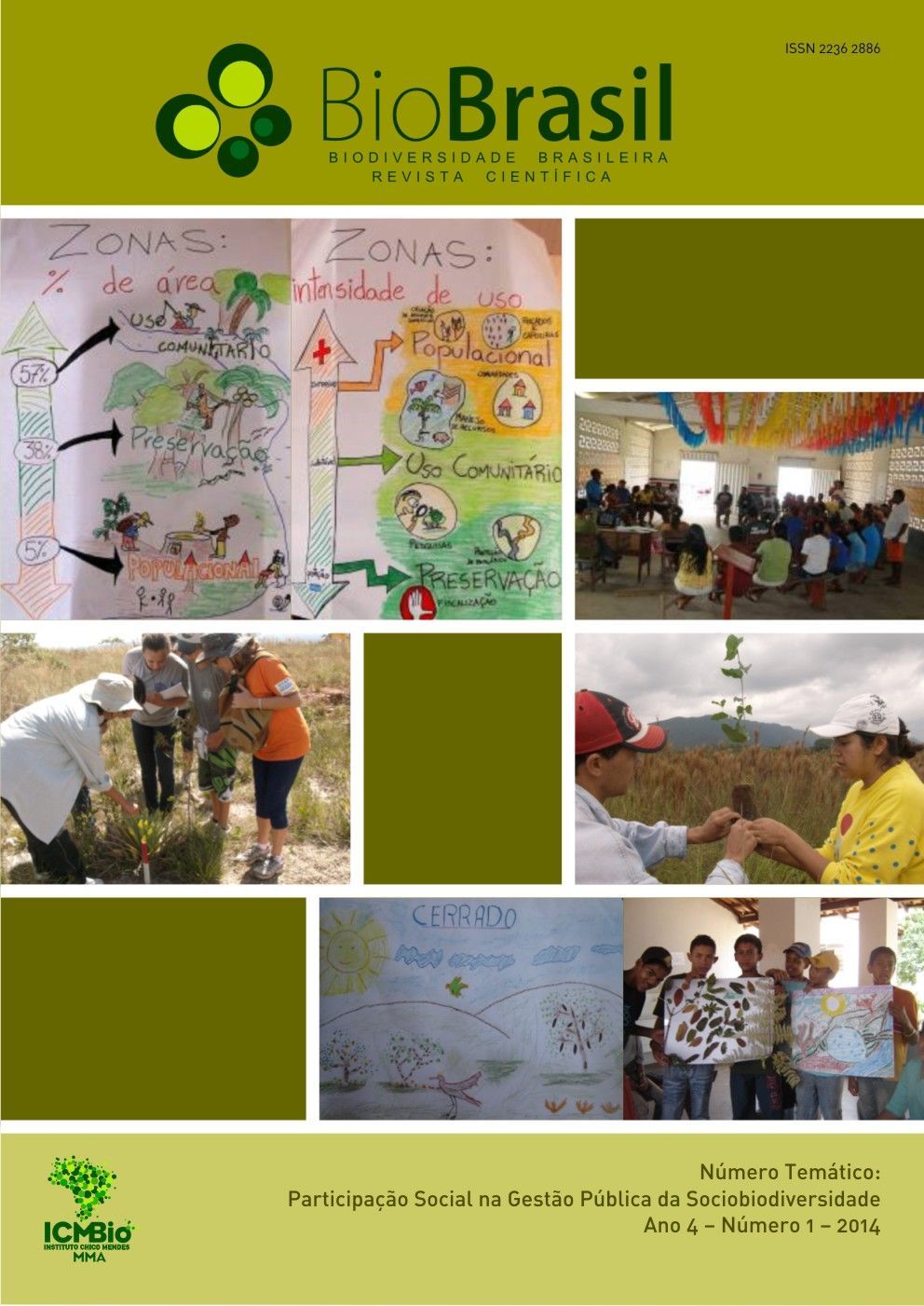Indicadores socioeconômicos na ARIE da Castanheira no Acre
DOI:
https://doi.org/10.37002/biodiversidadebrasileira.v4i1.338Keywords:
Amazon, ARIE, chestnut tree, conservation unitAbstract
The creation of the Area of Relevant Ecological "Seringal Nova Esperança" in 1998, in the city of Epitaciolândia - Acre, was a surprise even to those involved with the local social movement. Entities considered the reference for an environmental movement in the amazon, who positioned themselves as protagonists of achievements as Extractive Reserves and Community Forest Management of technology, did not understand what caused the federal government at the time to sign the the Decree of Creating of a category of Conservation Units an ARIE, with a tiny area of approximate 2,500 hectares, under the argument that the Brazil nut, Bertholletia excelsa Bonpl., was a forest species regarded as of high ecological interest. The past 12 years without the federal agency responsible for the consolidation of the unit initiate any action related to its management, the Chico Mendes Biodiversity Institute (ICMBio), institutional heir to the attributions related to the Conservation Units, faced with the dilemma of what to do to manage the ARIE. Through an unique partnership, ICMBio sought the support of the Course forestry engineering of the Federal University of Acre, for accomplishment of a set of 12 surveys scientific initiation, divided into 2 major studies: Socioeconomics and Biometrics. With employment of consecrated for Socioeconomic Lifting and Forest Inventory methodology was reached two crucial conclusions for making decisions. First, there is a density of Brazil nut that, although subject to intense anthropogenic pressure in the last 10 years corroborates the justification of high ecological interest used for creation of ARIE. Second, the resident population is made up of family agriculturists that has as main component of monetary income, not of barter, but that currency, the sale chestnut. These conclusions subsidized the main result of the study that was the choice of management strategy focused on increasing the area of ARIE and its consolidation as a Chestnut Seeds Orchard, probably the only of Amazonia.
References
Amaro, M.A. 2010. Quantificação do estoque volumétrico, de biomassa e de carbono em uma floresta estacional semidecidual no município de Viçosa - MG. Tese (Doutorado). Universidade Federal de Viçosa. 131 p.
Amaro, M.A. et al. 2012. Inventário Florestal na ARIE da Castanheira no Acre. Rio Branco/AC.
Associação Andiroba. 2002. Relatório de Avaliação do PD/A - PPG7. Rio Branco/AC.
BRASIL. Lei no 9.985 de 18 de julho de 2000. Regulamenta o art. 225, § 1°, incisos I, II, III e VII da Constituição Federal, institui o Sistema Nacional de Unidades de Conservação da Natureza - SNUC e dá outras providências. Diário Oficial da União. 19/07/2000. p1. 2000.
Cavalcanti, F.J.B. 1989. Levantamento sócio-econômico da Floresta Estadual do Antimary. FUNTAC. 86p.
CNS (Conselho Nacional dos Seringueiros). 1992. Relatório do levantamento sócio- econômico da Reserva Extrativista Chico Mendes e Projetos de Assentamentos Extrativista da região do Vale do Acre Purus. Convênio FUNTAC/CNS/CIDA. 109 p.
FUNTAC (Fundação de Tecnologia do Estado do Acre). 1988. Relatório preliminar socioeconomia no Projeto de Assentamento Extrativista São Luis do Remanso. Convênio Fundação Ford. 82 p.
ICMBio (Instituto Chico Mendes de Conservação da Biodiversidade). 2010. Mapas de acesso e ação antrópica na ARIE Seringal Nova Esperança. Rio Branco/AC.
ICMBio (Instituto Chico Mendes de Conservação da Biodiversidade). 2011. Memória da Expedição de Campo na Arie Seringal Nova Esperança. Relatório Técnico.
Rodrigues, E. 1991. Mapeamento das Relações Sócio-econômicas das Reservas Extrativistas do Cachoeira e São Luis do Remanso. FUNTAC. Rio Branco/AC.
Rodrigues, E. 1996. Levantamento socioeconômico e análise de viabilidade da Reserva Extrativista do São Luis do Remanso. Rio Branco. Acre. Dissertação (Mestrado). Curitiba/PR.
Rodrigues, E. 2006. Potencial Florestal dos produtos não madeireiros prioritários do Estado do Acre. SECTMA/ZEE. Rio Branco/AC.
Rodrigues, E. 2010. Socioeconomia da população residente na mata ciliar do Igarapé Batista em Rio Branco, Acre. Associação Andiroba. Rio Branco/AC.
Rodrigues, E. et al. 2012. ARIE Seringal Nova Esperança, levantamento socioeconômico: versão final. ICMBio/UFAC. Rio Branco/AC.
Tonini, H. 2007. Castanheira-do-brasil: uma espécie chave na promoção do desenvolvimento com conservação. Boa Vista: EMBRAPA Roraima, 3 p.
Downloads
Published
Issue
Section
License
Copyright (c) 2014 Os autores mantêm os direitos autorais de seus artigos sem restrições, concedendo ao editor direitos de ção não exclusivos.

This work is licensed under a Creative Commons Attribution-NonCommercial-NoDerivatives 4.0 International License.
Os artigos estão licenciados sob uma licença Creative Commons Atribuição-NãoComercial-SemDerivações 4.0 Internacional (CC BY-NC-ND 4.0). O acesso é livre e gratuito para download e leitura, ou seja, é permitido copiar e redistribuir o material em qualquer mídia ou formato.











